Guides
Toilet Tourism: Famous Smart Toilets Around the World Worth Visiting
Marvel at the innovative designs of famous smart toilets worldwide, where each visit offers an unforgettable experience that redefines the concept of restroom breaks.

Toilet tourism is growing, with famous smart toilets around the world just waiting for your visit. In Norway, check out the Stegastein viewpoint restroom, known for its stunning design, or the wave-shaped Ureddplassen toilet that honors WWII submarines. Over in Japan, the Tokyo Toilet Project features 17 high-tech public toilets, complete with heated seats and voice control. These unique facilities combine architecture with user experience, transforming mundane stops into attractions. As you explore these remarkable restrooms, you'll discover how they enhance travel memories and offer a glimpse into the future of toilet design. You'll want to learn even more!
Key Takeaways
- Norway features innovative restroom designs along scenic routes, such as the award-winning Stegastein viewpoint restroom and Ureddplassen's wave-shaped architecture.
- Japan's Tokyo Toilet Project showcases 17 luxury public toilets designed by renowned architects, emphasizing aesthetics and hygiene in urban spaces.
- High-tech toilets in Japan, like the TOTO WASHLET, offer advanced features such as voice control, heated seats, and contact-free operations for user comfort.
- Nature-inspired toilet solutions, like the Garden Toilet at Itabu Station, highlight eco-friendly designs that integrate seamlessly with beautiful landscapes.
- The rise of toilet tourism emphasizes unique restroom experiences that enhance travel narratives and promote positive perceptions of sanitation facilities.
Notable Toilets in Norway
Notable Toilets in Norway
Norway's Scenic Routes are home to some of the most notable toilets in the world, blending innovative design with breathtaking landscapes. As you travel through this stunning country, you'll discover public toilets that rival the renowned toilets in Japan for their state-of-the-art features and unique architecture.
These facilities often showcase modern aesthetics with rustic charm, creating an inviting atmosphere for travelers.
Take the Stegastein viewpoint restroom, recognized as one of the top 10 toilets globally by DesignCurial. Its architectural excellence offers you both functionality and beauty.
Then there's the Ureddplassen toilet, a wave-shaped structure on the Helgeland coast that serves as a memorial for a WWII submarine, seamlessly merging history with modern amenities.
Don't miss the Eggum restroom, built beneath the ruins of a German radar station, providing striking views and historical significance.
The Bukkekjerka toilet on Andøya island boasts panoramic ocean views, making it a perfect pit stop during your scenic journey.
Lastly, the plans for a golden loo on Senja island are creating buzz, showcasing Norway's commitment to stylish restroom facilities and the rising trend of toilet tourism.
Each of these notable toilets invites you to appreciate both nature and design in unexpected ways.
Architectural Significance

Blending functionality with artistic expression, contemporary toilets around the world have transformed into architectural landmarks that enhance public spaces. The Tokyo Toilet Project exemplifies this, featuring 17 luxury public toilets designed by renowned architects. Each toilet that makes use of modern aesthetics and traditional Japanese elements elevates both public hygiene and creativity.
For instance, Toyo Ito's egg-shaped facility mimics a mushroom, emphasizing harmony with nature, while Tadao Ando's cylindrical design integrates natural light and accessibility, showcasing universal design principles. Additionally, the movement towards minimalist spaces is reflected in these designs, echoing principles similar to those found in the Tiny House Movement, which values efficient and sustainable living environments.
In Norway, the Scenic Routes present restrooms as architectural masterpieces. The Oscarshaug restroom resembles a Viking helmet, built to withstand harsh weather with reinforced steel. Meanwhile, the Ureddplassen restroom on the Helgeland coast boasts a wave-shaped design and serves as a memorial for a WWII submarine, merging historical significance with modern architecture.
Japan's Yoyogi Fukamachi Mini Park toilet employs smart glass technology, enhancing user experience while prioritizing privacy and functionality. These remarkable designs prove that toilets can be more than just utilitarian spaces; they can become integral parts of the landscape, inviting admiration and reflection.
Future Developments

As we look ahead, the future of public restrooms is set to become even more innovative and visually striking. Countries like Norway and Japan are leading the way in transforming public toilets into attractions.
Norway's Public Roads Administration is developing unique restroom designs, including a forest-inspired facility that resembles an upside-down tree trunk. This design will creatively utilize wood from 60-70 trees, offering travelers an extraordinary stop on their journey to Hardangerfjord.
Additionally, just as cats have specific preferences for their environments, travelers will appreciate restrooms that are thoughtfully designed to enhance their experience environmental preferences of cats.
Meanwhile, Japan's Tokyo Toilet Project continues to evolve, showcasing designs from 17 renowned architects. These smart toilets not only focus on modern aesthetics but also incorporate advanced technology to frost glass for privacy and enhance user experience.
Features like voice control will make these restrooms more accessible and user-friendly.
Both Norway and Japan emphasize the importance of hygiene and functionality while creating visually appealing spaces. As public toilets become tourist attractions, you'll find that the future of restroom design blends architectural significance with cutting-edge technology, making your travels even more enjoyable.
Keep an eye on these developments, as they promise to redefine what you expect from public facilities around the globe.
Scenic Routes Overview

When you explore Norway's scenic routes, you'll discover not just stunning landscapes but also remarkable restrooms that double as architectural highlights.
These unique facilities enhance your travel experience, making stops along the way both convenient and memorable.
With proper toilet maintenance and regular inspections, these restrooms can provide a clean and efficient experience for travelers.
However, remember that access to these routes and their amenities is often seasonal, so plan your trip accordingly.
Architectural Highlights of Toilets
Have you ever thought about how a restroom can elevate your travel experience? In Norway's Scenic Routes, you'll discover 18 unique roads that feature architecturally significant public restrooms.
These high-tech toilets aren't just functional; they're designed to enhance your journey through stunning natural landscapes. The design of these restrooms can inspire your own home decor, as they often incorporate natural materials and aesthetics that reflect the surrounding environment, similar to how country flair in dining rooms blends rustic elements with modern furnishings.
Take the Eggum restroom, for instance. Designed by Snøhetta, it sits beneath the ruins of a German radar station, blending historical significance with modern toilet architecture.
The Oscarshaug restroom, reinforced for harsh weather, resembles a Viking helmet, showcasing an artistic expression that's both practical and visually striking.
Upcoming designs, like the forest-inspired restroom that mimics an upside-down tree trunk, reflect Norway's commitment to transforming ordinary toilets into tourist attractions. Each restroom is strategically located to provide picturesque stops, making them accessible to people who want to appreciate both the architecture and the breathtaking scenery.
Next time you're on the road, consider how these unique restrooms can enrich your travels. They're more than just a pit stop; they're part of the adventure!
Scenic Route Accessibility
Exploring Norway's scenic routes offers not just breathtaking views but also unique challenges regarding accessibility. With 18 stunning routes to choose from, you'll find each one showcases remarkable landscapes and attractions, enhancing your travel experience.
However, accessibility varies greatly; many public toilets are only reachable during the summer months. This limitation highlights the need for careful planning, especially for those who may need to navigate emotional volatility during their journey, guaranteeing everyone feels comfortable and supported. Understanding the importance of self-care can also enhance your travel experience.
As you navigate these scenic routes, you'll discover architecturally significant restrooms that turn a necessary stop into a moment of interest, adding to the allure of toilet tourism. These thoughtfully placed public toilets are strategically located at rest areas, encouraging you to take breaks and explore the beautiful surroundings.
While enjoying your journey, remember that each scenic route offers ample opportunities to capture picturesque memories. Respect the public spaces and facilities to guarantee they remain enjoyable for future travelers.
Tourist Attraction Integration
Norway's scenic routes are more than just pathways through stunning landscapes; they serve as a canvas for innovative design that transforms restrooms into tourist attractions. The Norwegian Public Roads Administration has embraced the idea of turning ordinary toilets into must-see spots for travelers. These architectural masterpieces enhance your journey and encourage exploration of the breathtaking surroundings.
The commitment to integrating these facilities with the natural beauty reflects a global trend similar to the Toilet Project in Japan, where toilets are designed with both functionality and aesthetics in mind. As you travel along these scenic routes, you'll find that these toilets not only provide essential services but also enhance your experience.
| Restroom Name | Unique Feature |
|---|---|
| Eggum | Stunning design by Snøhetta |
| Oscarshaug | Blends seamlessly with the landscape |
| Vøringsfossen | Breathtaking views of waterfalls |
| Stegastein | Scenic overlook and modern design |
| Gaupne | Eco-friendly materials |
These rest areas provide a space for people to relax, enjoy the scenery, and appreciate the connection between nature and innovative restroom design.
Travel Inspiration and Offers

Discover the unique charm of traveling with a focus on innovative restroom experiences that enhance your journey.
Toilet tourism is on the rise, offering memorable stops that showcase unique restroom designs and advanced functionalities. For those seeking a relaxing getaway, consider how these unique stops can blend adventure and luxury, similar to Island Getaways, while you explore.
If you're looking for travel inspiration, consider these highlights:
- Tokyo Toilet Project: Explore 17 uniquely designed public toilets in Shibuya, created by renowned architects to improve public hygiene and attract curious tourists.
- Norway's Scenic Routes: Journey through Norway's 18 scenic roads, where architecturally significant restrooms transform into tourist attractions, providing stylish stops amid breathtaking landscapes.
- Wave-shaped Ureddplassen: Visit Norway's stunning Ureddplassen, a restroom that's more than functional—it's a work of art that enhances the travel experience.
- High-tech Japanese Toilets: Experience Japan's advanced toilets, equipped with innovative features like heated seats and bidets, ensuring a comfortable and hygienic visit.
With these unique restroom experiences, your travels will be enriched, creating lasting memories and stories to share.
Evolution of Japanese Toilets
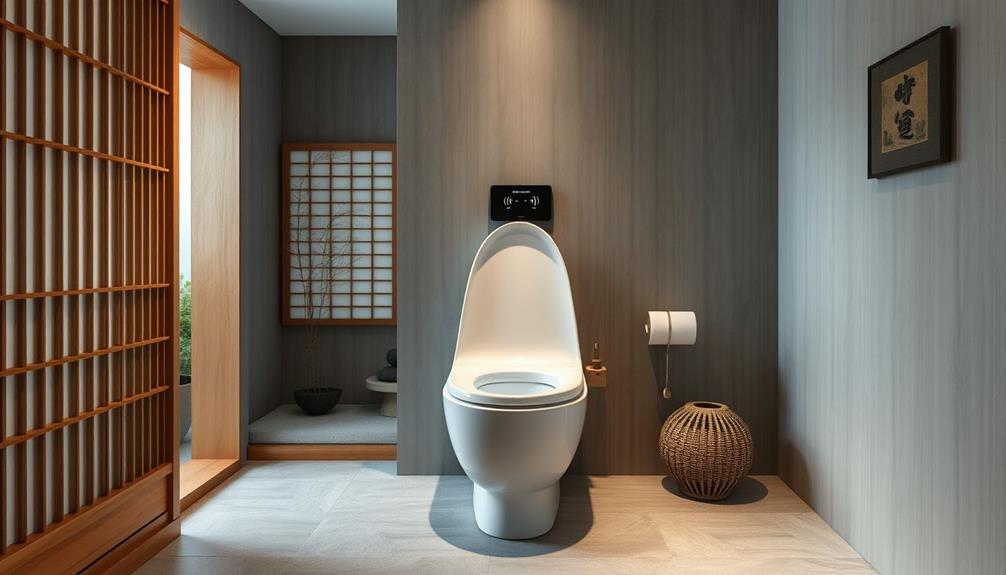
The evolution of Japanese toilets reflects a fascinating blend of tradition and innovation that has transformed restroom experiences.
You'll notice this shift from traditional squat designs to high-tech washlets, which greatly enhance comfort and hygiene. One of the most revolutionary advancements is the TOTO WASHLET, introduced in 1980. With over 50 million units sold, it features a heated seat and bidet functions, making it a staple in many Japanese homes. This innovation parallels trends in other investment options like diversification of retirement portfolio, showcasing how industries adapt to modern needs.
Moreover, the Tokyo Toilet Project showcases the creativity of 17 architects who've designed public restrooms that harmonize modern aesthetics with traditional Japanese elements.
This initiative highlights Japan's commitment to public hygiene and beautiful facilities. You'll find that even historical toilets, like those at Kyoto's Tofuku-ji Temple, dating back to the early Muromachi era, have been preserved to reflect the country's rich culture.
As toilet tourism gains popularity, the unique designs and cleanliness of Japanese restrooms promote both cultural significance and artistic expression.
When you visit Japan, experiencing these innovative toilets will surely add an unforgettable aspect to your trip!
Innovative Designs in Japan

Innovative designs in Japan's public restrooms seamlessly blend functionality with artistry, creating spaces that are both practical and visually striking.
The Tokyo Toilet Project showcases 17 luxury public toilets, each crafted by renowned architects, emphasizing modern aesthetics intertwined with traditional Japanese elements. This initiative reflects a commitment to user experience and interface design, as these restrooms are designed to enhance comfort and accessibility, similar to the focus on user experience metrics in digital platforms.
Here are four standout features that make these restrooms remarkable:
- Natural Light: Many designs, like Tadao Ando's cylindrical restroom in Jingu-Dori Park, incorporate large windows that flood the space with natural light, enhancing comfort.
- Accessibility: These facilities prioritize accessibility, ensuring that everyone, regardless of mobility challenges, can enjoy a pleasant experience.
- High-Tech Features: Expect voice control, contact-free operations, and smart glass for privacy—these innovations elevate your restroom experience while maintaining hygiene standards.
- Public Art: The unique architectural elements transform restrooms into public art installations, fostering cultural appreciation and community engagement.
Japan's commitment to sustainability shines through the use of eco-friendly materials, showcasing that innovative designs can be both beautiful and environmentally conscious.
When you visit, you'll find that these restrooms are more than just functional—they're a celebration of design and culture.
Nature-Inspired Toilet Solutions

Nature-inspired toilet solutions in Japan transform the restroom experience by integrating elements of the natural world into design. One standout example is the Garden Toilet at Itabu Station, where transparent walls surround you with lush greenery, offering a scenic view while you attend to your needs.
Then there's the Oath Hill Park toilets, shaped like the iconic Mount Fuji, providing not just functional facilities but also breathtaking vistas for visitors. These innovative designs reflect a growing trend towards enhancing user experiences, similar to how headphone extension cables improve sound quality for listeners.
Another remarkable spot is the Resuto Ujo restaurant's toilet, uniquely nestled within a miniature Japanese garden, allowing you to enjoy natural beauty even in this private space. You can also find eco-friendly toilets in Shizuoka prefecture that utilize sustainable resources like sawdust and microorganisms, reflecting a commitment to environmental responsibility in restroom design.
For women seeking a serene experience, facilities designed exclusively for women, such as those in Ichihara's Garden Toilet, embrace natural settings that promote comfort and privacy.
These innovative, nature-inspired toilet designs elevate your restroom experience, making it more than just a pit stop—it's a moment of tranquility amid the beauty of Japan's landscapes.
Technological Advancements in Toilets
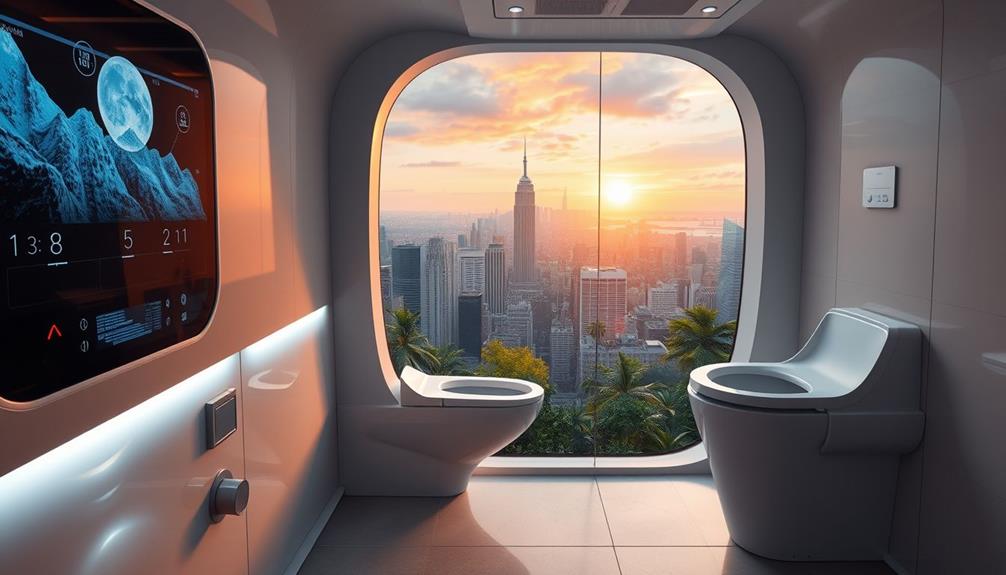
Transforming your bathroom experience, high-tech toilets in Japan offer a blend of comfort and cutting-edge technology.
These marvels incorporate advanced functionalities that redefine sanitation practices and enhance your daily routine.
Here are some standout features you can expect from these innovative toilets:
- Heated Seats: Say goodbye to cold surprises and enjoy the warmth of heated seats, especially during chilly mornings.
- Bidet Functions: Experience enhanced cleanliness with integrated bidet features that cater to your hygiene needs.
- Smart Technology: Voice-activated controls and sensors for automatic lid opening make using the toilet a hands-free experience.
- Eco-Friendliness: Many modern toilets emphasize water-saving technologies, greatly reducing water consumption while promoting sustainable practices.
Japan's Tokyo Toilet Project showcases how advanced materials, like smart glass, blend privacy with aesthetic appeal.
Continuous research in toilet technology also brings features such as air deodorizers and adjustable water temperatures to the forefront.
With these advancements, high-tech toilets not only prioritize user convenience and health but also contribute positively to the environment.
Frequently Asked Questions
What Is the Most Famous Toilet in the World?
You might think of the "Golden Toilet" at Blenheim Palace when asked about the most famous toilet. This extravagant 18-karat gold lavatory captures attention, showcasing art and luxury in an unexpected setting. Don't miss it!
Which Country Is Famous for Toilet?
When you think about porcelain thrones, Japan instantly comes to mind. Its innovative washlets offer a luxurious experience, blending comfort and technology seamlessly. You'll find these fascinating features turning everyday visits into memorable moments.
What Is a Must Wear Inside the Toilet in Japan?
When you visit a restroom in Japan, you're expected to wear special toilet slippers. These disposable slippers keep the area clean and hygienic, reflecting the country's strong emphasis on cleanliness and respect for shared spaces.
What Is Special About Japanese Toilets?
Imagine sinking into a heated seat, surrounded by sleek design. Japanese toilets blend technology and comfort, featuring bidet sprays and self-cleaning functions, transforming your experience into one of luxury, hygiene, and sustainability you won't forget.
Conclusion
In the world of toilet tourism, you've got a unique chance to experience the blend of culture and innovation. From Norway's architectural marvels to Japan's high-tech wonders, these restrooms are more than just facilities; they're a reflection of human creativity. Just like a hidden gem waiting to be discovered, each visit offers inspiration and a story worth sharing. So why not chart your course and embrace the quirky side of travel? It's a flush of adventure you won't forget!
With an impeccable eye for detail and a passion for bathroom-related, Ava leads our editorial team gracefully and precisely.
Under her guidance, Best Modern Toilet has flourished as the go-to resource for modern bathroom enthusiasts. In her free time, you might find Ava exploring antique shops and looking for vintage bathroom fixtures to add to her collection.
Guides
Smart Toilet Regulations and Standards: Navigating the Legal Landscape
In navigating smart toilet regulations, understanding safety standards and consumer laws is crucial for success—discover how to stay ahead in this evolving landscape.

Steering through smart toilet regulations is essential for compliance and market success. You need to guarantee your product meets safety standards like UL and FCC certifications. Water efficiency is important too, so consider obtaining WaterSense certification. Keep in mind the significance of quality control and testing to maintain consumer trust. Protecting your intellectual property through patents and trademarks is critical as well. By adhering to consumer protection laws, you safeguard against legal issues. Future trends might introduce stricter standards, pushing innovation further. To truly understand all nuances, there's much more you can discover about this evolving legal landscape.
Key Takeaways
- Compliance with UL, FCC, and WaterSense certifications ensures smart toilets meet essential safety, electrical, and water efficiency standards.
- Regular quality control and compliance testing by accredited laboratories maintain product reliability and adherence to safety regulations.
- Intellectual property protections, such as trademarks and patents, safeguard unique technologies and brand identity in the competitive smart toilet market.
- Understanding consumer protection laws and warranty policies is crucial for manufacturers to minimize liability and ensure customer satisfaction.
- Familiarity with local, state, and federal regulations helps navigate the complex legal landscape of smart toilet manufacturing and marketing.
Overview of Smart Toilet Regulations
When considering smart toilets, it's important to understand the various regulations that guarantee their safety and efficiency. Smart toilets comply with U.S. safety, electrical, and plumbing regulations, making sure they meet established standards for consumer protection. For instance, UL certification is mandatory to verify the electrical safety of components like heated seats. This step is significant for your peace of mind.
Additionally, the inclusion of features such as diversification of retirement portfolio may also apply to other investments in home technology, highlighting the necessity of thorough research before purchase.
If your smart toilet utilizes wireless technology, it must also have FCC certification to prevent electromagnetic interference with other devices. Additionally, you'll find that many smart toilets boast WaterSense certification, highlighting their commitment to water efficiency—an appealing feature for environmentally conscious consumers.
In the European Economic Area (EEA), compliance with CE marking is necessary for these products, making sure they adhere to health, safety, and environmental protection standards. Understanding these regulatory requirements for products is essential not only for manufacturers but also for consumers like you who want to confirm that their smart toilets are safe and efficient.
Key Compliance Standards
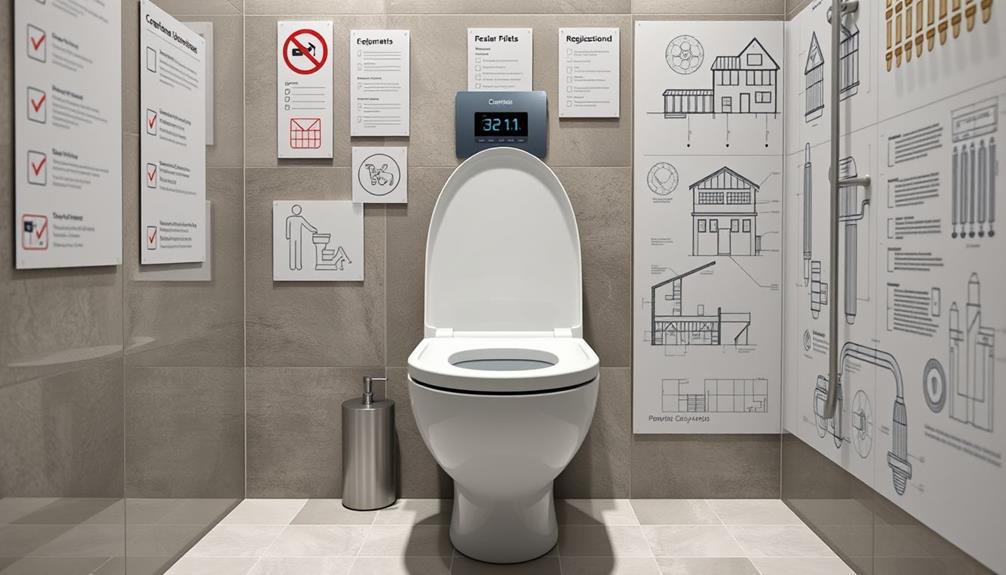
Steering through the world of smart toilets requires an understanding of key compliance standards that guarantee safety and performance. First and foremost, you'll need to look for compliance marks and information that demonstrate adherence to significant regulations.
For instance, UL certification is critical for verifying Electrical Safety, ensuring that components like heated seats are free from electrical hazards. If your smart toilet includes wireless technology, it must also meet FCC certification standards to prevent electromagnetic interference with other devices.
Furthermore, understanding toilet water mechanics can aid in selecting models that optimize flushing efficiency while meeting compliance standards.
Additionally, WaterSense certification is important for smart toilets, as it indicates compliance with water efficiency standards. This certification not only appeals to environmentally conscious consumers but also aligns with sustainable practices.
While Energy Star certification isn't mandatory, it can enhance your product's market appeal by promoting energy-efficient models that help reduce utility costs.
Safety and Electrical Regulations
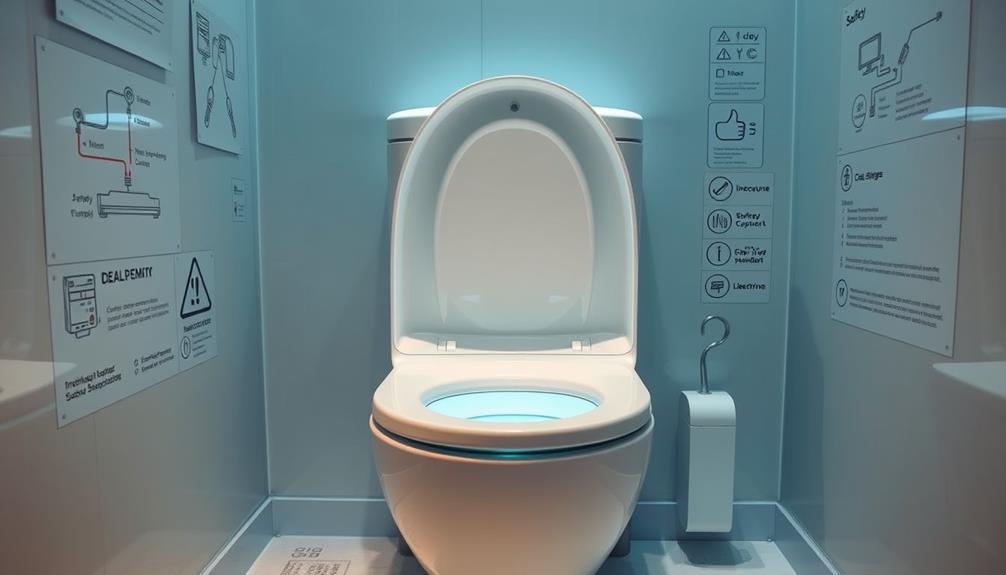
Safety and electrical regulations play an important role in the design and functionality of smart toilets. To guarantee safe electrical installations and prevent fire hazards, smart toilets must comply with the National Electric Code (NEC). Additionally, if your smart toilet features electrical components, it needs UL (Underwriters Laboratories) certification, which verifies its safety and performance under specified conditions.
Regular maintenance guarantees peak performance and longevity, similar to how air purifiers improve indoor air quality by filtering out pollutants. For smart toilets equipped with wireless technology, compliance with the Federal Communications Commission (FCC) standards is vital. These regulations help prevent electromagnetic interference with other devices, ensuring your smart toilet operates smoothly.
Furthermore, adherence to the American National Standards Institute (ANSI) standards is important for plumbing fixtures like smart toilets, confirming they meet stringent safety and performance requirements.
Maintaining compliance isn't a one-time solution either; regular testing and certification by accredited laboratories are necessary to keep up with evolving safety and electrical regulations in the smart toilet market.
Water Efficiency Certifications

Water efficiency certifications are essential for anyone looking to make a sustainable choice with their smart toilet. One of the most recognized certifications is the WaterSense certification, administered by the U.S. Environmental Protection Agency (EPA). This certification guarantees that your toilet meets strict standards for water efficiency, using at least 20% less water than standard models while maintaining performance.
By choosing certified products, you can also contribute to reducing the overall carbon emissions associated with water treatment processes, similar to how geothermal energy harnesses the earth's heat for eco-friendly solutions.
When considering a smart toilet, keep these key points in mind:
- Water Usage: Toilets with the WaterSense label must use no more than 1.28 gallons per flush.
- Water Savings: Replacing older toilets with WaterSense labeled models could save your household over 13,000 gallons of water annually.
- Rigorous Testing: Products must undergo rigorous testing to prove consistent performance in flushing and overall reliability.
- Additional Certifications: Many smart toilets also pursue Energy Star certification, appealing to environmentally conscious consumers by promoting energy efficiency.
Choosing a smart toilet with these water efficiency certifications not only contributes to water conservation but also helps reduce utility bills, making it a smart choice for both your wallet and the planet.
Intellectual Property Considerations

When you're developing smart toilets, protecting your intellectual property is key.
Understanding the importance of quality assurance in your design process can help guarantee that your innovations meet industry standards. You should focus on trademark strategies to secure your brand and consider the patent filing process to safeguard your unique technologies.
Additionally, licensing agreements can play a crucial role in maximizing the value of your innovations while keeping competitors at bay.
Trademark Protection Strategies
Trademark protection is a vital strategy for smart toilet manufacturers aiming to establish and maintain their brand identity in a competitive market.
By securing trademarks, you can safeguard your logos, names, and slogans from unauthorized use, preserving your brand integrity and reputation.
As the landscape of AI applications in various industries, including smart technologies, evolves, guaranteeing robust trademark protections becomes increasingly essential to mitigate risks associated with potential infringements and to enhance AI ethics and privacy concerns surrounding brand identity.
Here are some effective trademark protection strategies to take into account:
- Register with the USPTO: This provides legal advantages like nationwide protection and the ability to enforce your rights against infringers.
- Conduct thorough trademark searches: Identifying potential conflicts before registration helps you avoid costly legal disputes over similar trademarks.
- Monitor and enforce your trademark rights: Actively watching for infringements and taking action against counterfeit products guarantees your brand remains strong.
- Renew trademarks periodically: Keeping your trademarks updated and compliant with local and international laws is key to sustaining protection in a crowded marketplace.
Patent Filing Process
Maneuvering the patent filing process is vital for smart toilet manufacturers looking to protect their innovations. Conducting a thorough prior art search not only guarantees your invention's novelty but also enhances your keyword optimization strategy, which is important for establishing topical authority.
This search can take weeks and requires expertise in patent databases. Once you've confirmed your idea is unique, prepare a detailed patent application that includes claims, technical specifications, and drawings. These elements greatly influence the approval process.
After submitting your application to the U.S. Patent and Trademark Office (USPTO), expect a review period of about 18 months. During this time, you might receive office actions asking for additional information or amendments, so be ready to respond promptly.
Filing costs can vary widely; basic fees for a utility patent application start around $300, but total costs, including attorney fees and documentation, can exceed $10,000.
Licensing Agreements Importance
How can licensing agreements safeguard your innovations in the smart toilet industry? These agreements are crucial for protecting your intellectual property rights, guaranteeing that your patented technologies and designs are used legally.
By clearly defining the scope of usage—including geographical limits and duration—you maintain control over your proprietary innovations. The need for legal safeguards in any innovative field is paramount, as it mirrors the necessity of identifying narcissistic behaviors in interpersonal relationships to protect oneself from emotional harm.
Here's why you should prioritize licensing agreements:
- Risk Mitigation: Clearly outline rights and obligations to reduce the risk of infringement lawsuits.
- Legal Compliance: Guarantee that all parties adhere to the terms, helping prevent costly legal disputes.
- Royalties and Exclusivity: Define payment structures and exclusivity terms to maximize your revenue and competitive edge.
- Brand Protection: Prevent unauthorized use of your intellectual property, enhancing brand value and fostering consumer trust.
Consulting legal experts to draft thorough licensing agreements is essential. They should address potential issues like termination clauses, guaranteeing your interests are protected.
Importation and Customs Requirements

Importing smart toilets into the U.S. involves maneuvering a complex landscape of regulations and standards. You need to comply with safety regulations set by the Consumer Product Safety Commission (CPSC) and adhere to local plumbing codes.
Additionally, understanding the implications of tax-free transfers can be beneficial when considering the financial aspects of your importation process. Vital documentation for customs procedures for importing includes invoices, packing lists, compliance certificates, and specific declarations for electrical and plumbing components.
Understanding applicable tariffs and duties is essential, as these can greatly affect your overall import costs and pricing strategies. You'll want to familiarize yourself with the Harmonized Tariff Schedule (HTS) to accurately classify your products for duty assessment and compliance verification.
Partnering with experienced freight forwarders can streamline your importation process, addressing all customs requirements and logistical challenges efficiently. They'll help guarantee that you have the necessary documentation and that you meet all regulatory landscape stipulations.
With careful planning and the right support, you can navigate the complexities of importing smart toilets, making the process smoother and more efficient. This preparation sets the stage for successful entry into the U.S. market while minimizing potential setbacks.
Testing and Quality Assurance
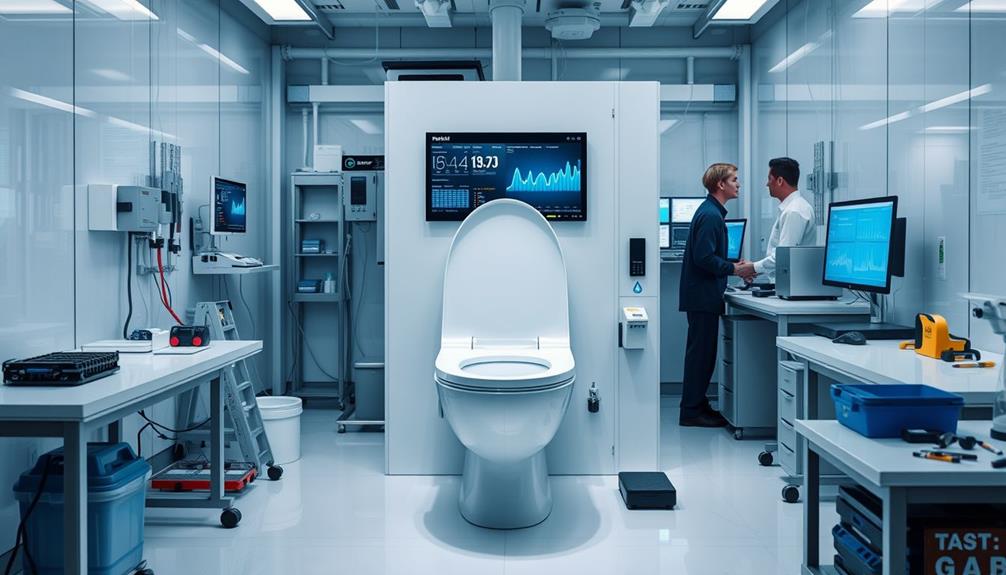
When you're designing a smart toilet, you'll need to focus on compliance testing procedures to make sure it meets all safety and performance standards.
Implementing strict quality control measures during production is essential to maintain consistency and reliability. This way, you can guarantee that your product not only complies with regulations but also delivers the performance users expect.
Additionally, understanding the importance of compliance and safety standards in the home cleaning industry can provide valuable insights into creating a trustworthy product.
Confirming that all components are tested for durability and functionality will further bolster user confidence in your smart toilet.
Compliance Testing Procedures
Compliance testing procedures for smart toilets play an essential role in guaranteeing that products meet safety and performance standards.
To successfully navigate the compliance testing landscape, you'll need to focus on several key areas:
- Safety Regulations: Confirm adherence to U.S. safety, electrical, and plumbing regulations to protect consumers and facilitate market entry.
- Accredited Laboratories: Utilize accredited labs for compliance testing, such as obtaining UL certification for electrical safety and FCC certification for wireless technology.
- WaterSense and Energy Star Certifications: Aim for WaterSense certification to highlight water efficiency and appeal to eco-conscious consumers, while Energy Star certification can enhance market appeal for energy-efficient models.
- Ongoing Quality Assurance: Establish continuous quality assurance processes post-certification to maintain compliance with evolving regulatory standards and guarantee product integrity.
Staying informed about changing regulations and testing requirements is vital, as these processes can vary by state or region within the U.S. market.
Quality Control Measures
Ensuring the highest quality in smart toilets demands rigorous quality control measures throughout the production process. You need to prioritize compliance testing with U.S. safety, electrical, and plumbing regulations to guarantee product reliability and safety. Accredited laboratories must conduct necessary compliance testing, such as UL certification for electrical components and FCC certification for wireless technology, to meet legal requirements.
During production, implement strict quality control protocols, including thorough inspections and testing of materials. This approach helps prevent defects and maintain high-quality outputs.
It's also important to establish continuous quality assurance processes post-certification to monitor product integrity and adherence to established standards throughout the product lifecycle.
Regular audits and assessments of manufacturing practices are essential for ensuring ongoing compliance with regulatory standards. By doing so, you not only meet but exceed consumer expectations for quality and safety.
This commitment to quality control measures not only protects consumers but also enhances your brand's reputation in a competitive market. Remember, maintaining high standards throughout the production process is key for the success of your smart toilet products.
Liability and Legal Risks
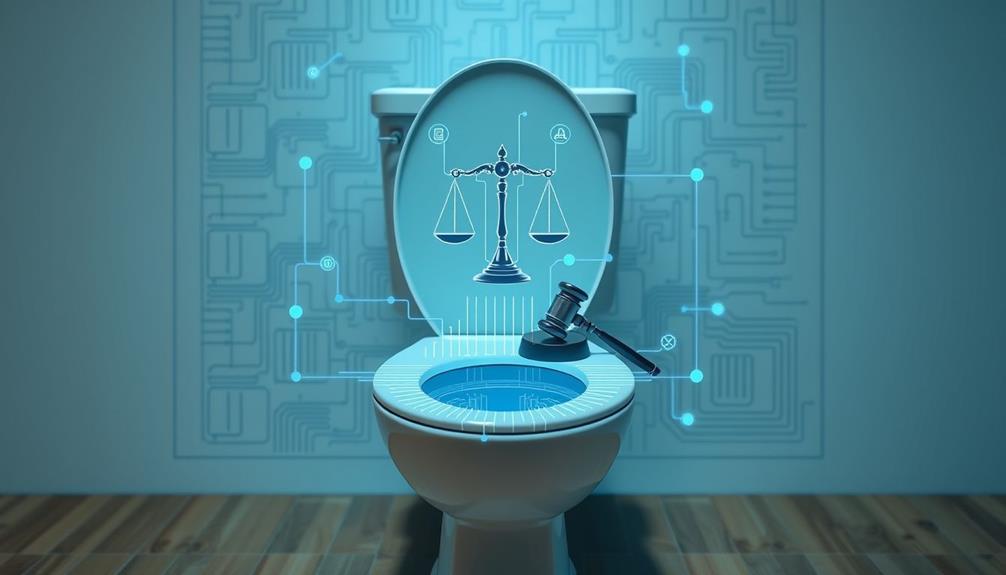
Maneuvering the landscape of liability and legal risks in the smart toilet industry is vital for manufacturers.
To protect your business, it's important to focus on a few key areas:
- Compliance with Safety Regulations: Verify your products meet all safety regulations to minimize liability from defects or failures that may cause injury.
- Obtaining Certifications: Don't overlook necessary certifications like UL or FCC. These verify your product's safety and compliance with electrical and wireless standards.
- Intellectual Property: Be aware of patent laws. Intellectual property infringements can expose you to significant legal risks and financial penalties.
- Clear Warranty Policies: Establish warranty policies that follow local laws. This helps avoid disputes related to product performance and customer expectations.
Consumer Protection Laws
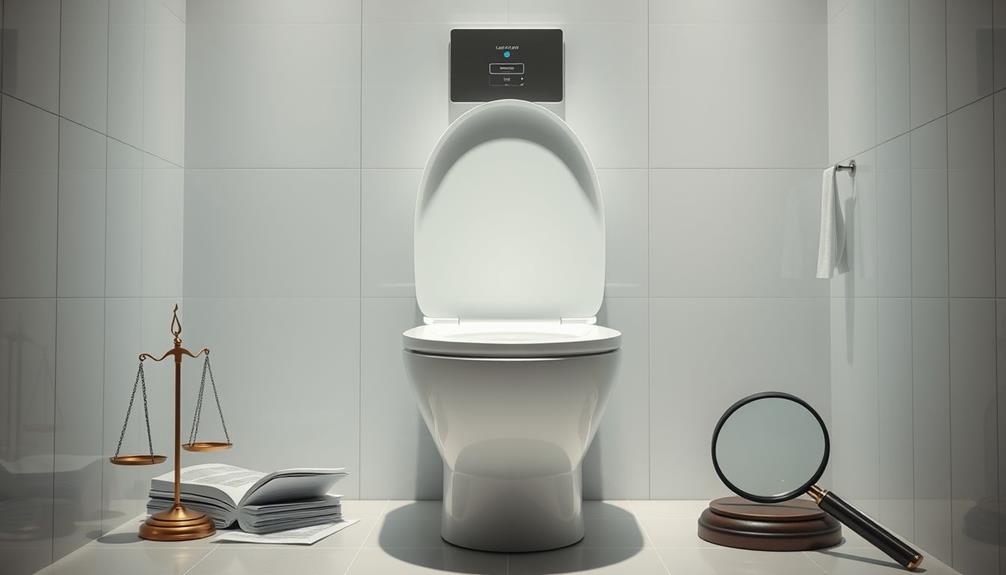
When you buy a smart toilet, it's essential to understand the legal compliance requirements that protect your rights as a consumer.
Warranty and liability issues come into play, ensuring that manufacturers are held accountable for defects and failures.
Knowing these consumer protection laws can help you make informed choices and feel secure in your purchase.
Legal Compliance Requirements
Smart toilets must navigate a complex landscape of legal compliance requirements to guarantee consumer protection. As a manufacturer, you'll need to confirm that your products are safe, reliable, and accurately labeled. Here are key compliance areas to focus on:
- Consumer Product Safety Commission (CPSC): Smart toilets must adhere to regulations set by the CPSC, which outlines safety standards to protect consumers from hazards.
- Truth-in-Advertising Laws: The Federal Trade Commission (FTC) enforces laws requiring that your marketing materials accurately represent the capabilities of your smart toilets, avoiding deceptive claims.
- Warranty Policies for Smart Toilets: You must comply with the Magnuson-Moss Warranty Act, which mandates clear disclosure of warranty terms and conditions to consumers, ensuring transparency.
- State-Specific Laws: Be aware of additional consumer protection laws in different states, as these may impose extra requirements on product safety and marketing practices.
Navigating these legal compliance requirements is essential to building trust with your customers and avoiding potential legal pitfalls.
Warranty and Liability Issues
How can you guarantee that your warranty policies protect both your customers and your business? First, make certain your warranty terms comply with consumer protection laws. These laws require you to clearly outline the coverage duration and conditions, safeguarding your buyers' interests. Typically, warranties must cover defects in materials and workmanship for a minimum of one year, but consider offering extended warranties to enhance customer trust.
Liability issues can arise if your smart toilet malfunctions, potentially causing property damage or personal injury. To mitigate these risks, implementing robust liability insurance policies is vital. Under the Magnuson-Moss Warranty Act, you must provide detailed information about warranty coverage, including any limitations or exclusions. This transparency helps prevent misunderstandings and builds customer confidence.
Failing to adhere to warranty and liability regulations can lead to legal disputes, penalties, and reputational damage. By prioritizing compliance and clearly communicating warranty terms, you not only protect your customers but also shield your business from costly liabilities.
Future Regulatory Trends

As smart toilet technology advances, regulatory bodies are poised to tighten safety and performance standards to keep pace with innovative features like wireless connectivity and automated functionalities.
You can expect several future regulatory trends that will shape the industry:
- Stricter Safety Standards: Enhanced electrical safety regulations will likely require rigorous certification for components like heated seats and sensors, guaranteeing user safety.
- Water Efficiency Mandates: Increased consumer demand for efficiency will drive wider adoption of WaterSense certification, compelling manufacturers to innovate and meet enhanced water conservation standards.
- Cybersecurity Guidelines: As smart home integration rises, regulators will establish guidelines to guarantee interoperability and protect user data, addressing potential privacy concerns.
- Environmental Compliance: Stricter adherence to regulations like RoHS and WEEE will push manufacturers toward eco-friendly materials and sustainable disposal practices, supporting environmental sustainability.
Frequently Asked Questions
What Are the Limitations of Smart Toilets?
Smart toilets can be expensive, often needing modifications for older plumbing. You might face complex maintenance issues and find local codes restrict installation. Plus, you may struggle to use advanced features if you're not tech-savvy.
What Are the Requirements for a Toilet Area?
Toilet areas must have hot and cold running water, hand soap, and drying options. They need separate facilities for each sex, accessible restrooms, and prompt access to guarantee sanitation standards are met for everyone.
Conclusion
As you navigate the intricate landscape of smart toilet regulations, remember that staying informed is key. By embracing compliance standards and prioritizing safety, you'll not only enhance your product's appeal but also fortify consumer trust. While the road ahead may seem challenging, the evolving regulatory environment offers opportunities for innovation. So, as you venture forth, consider these guidelines your compass, steering you toward a harmonious blend of technology and responsibility in the restroom revolution.
With an impeccable eye for detail and a passion for bathroom-related, Ava leads our editorial team gracefully and precisely.
Under her guidance, Best Modern Toilet has flourished as the go-to resource for modern bathroom enthusiasts. In her free time, you might find Ava exploring antique shops and looking for vintage bathroom fixtures to add to her collection.
Guides
The Impact of Smart Toilets on Real Estate Value and Home Sales
Boost your home’s appeal and value with smart toilets—discover how these innovative features can transform your selling strategy and attract buyers.

Smart toilets can greatly enhance your property's value and speed up home sales. By incorporating modern features like heated seats and automatic flushing, you make your home more appealing to buyers. These toilets often lead to lower utility bills, attracting eco-conscious individuals. Investing in smart toilets can yield returns of 60-70%, making them a financially sound decision. Homes equipped with these modern amenities sell faster in competitive markets. If you're curious about how smart toilets fit into current real estate trends and buyer preferences, there's much more to discover.
Key Takeaways
- Smart toilets enhance property appeal, leading to faster sales and higher resale values in competitive real estate markets.
- Long-term savings on water and utility bills make smart toilets a financially sound investment for homeowners.
- Properties equipped with smart toilets often yield a return on investment of 60-70% during renovations.
- Eco-friendly features of smart toilets attract environmentally conscious buyers, increasing marketability.
- The growing trend towards smart home technologies is driving demand for modern amenities like smart toilets.
Overview of Smart Toilets
Smart toilets are revolutionizing the way we think about bathroom fixtures, stepping up from luxury items to essential modern conveniences.
These innovative fixtures enhance your bathroom experiences with advanced features like automatic flushing, heated seats, and bidet functions. They not only provide comfort and convenience but also promote water efficiency, making them an attractive investment for homeowners.
Additionally, their ability to reduce water usage aligns with modern plumbing practices, as replacement of old toilets can improve efficiency.
With prices ranging from $300 to $5,000, smart toilets cater to various market segments, allowing you to choose one that fits your budget.
Keep in mind, though, that installation may require a dedicated Ground Fault Circuit Interrupter (GFCI) outlet and professional assistance, which can add to your overall costs.
However, the long-term benefits often outweigh these initial expenses.
Economic Implications of Smart Toilets
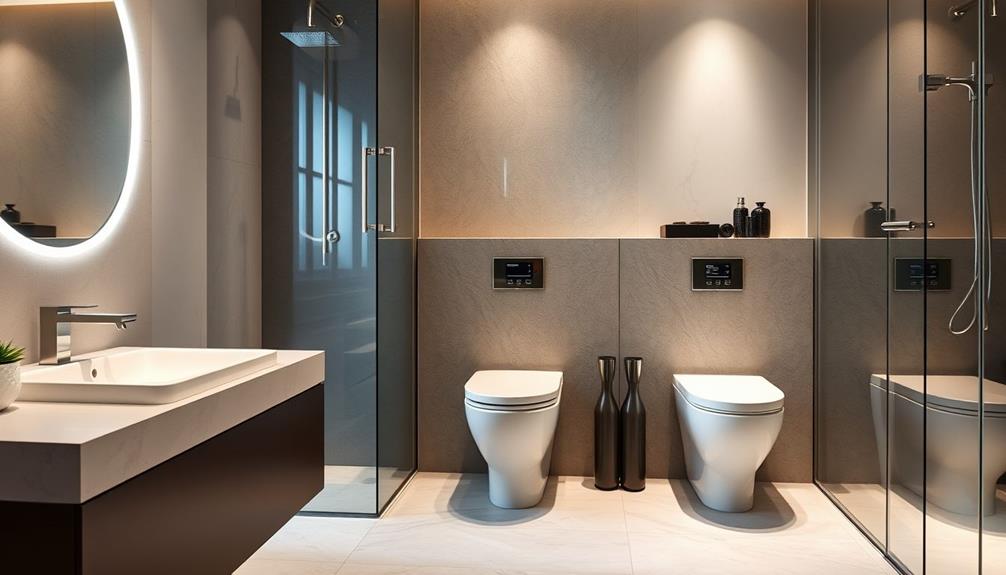
Investing in smart toilets can greatly impact your property's resale value, making it a savvy choice for homeowners looking to enhance their appeal in the real estate market. The initial cost of these smart technologies, ranging from $300 to $5,000, can seem considerable, but the long-term benefits often outweigh this expense.
By incorporating energy-efficient features, you're not only promoting water conservation but also attracting environmentally conscious buyers who value sustainability. Additionally, just as geothermal energy harnesses the earth's heat for eco-friendly benefits, smart toilets offer a similar advantage by reducing water usage and contributing to environmental conservation.
A bathroom remodel that includes smart toilets can lead to a remarkable return on investment. Properties equipped with these advanced amenities stand out in listings, generating increased buyer interest and potentially leading to higher offers.
Homes with smart toilets can experience faster sales in competitive markets, as buyers are drawn to luxurious features that promise modern living.
Moreover, the long-term savings on water and utility bills—averaging a reduction of up to 50% in water usage—make your home even more appealing to potential buyers.
Benefits of Smart Toilets
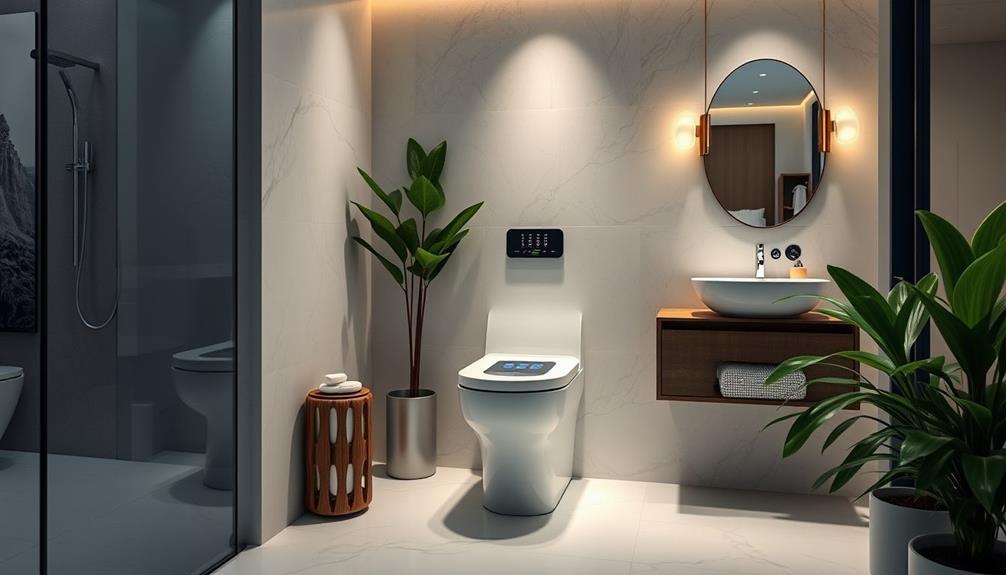
With their advanced features and modern conveniences, smart toilets offer numerous benefits that enhance both comfort and hygiene. These innovative fixtures come equipped with features like heated seats, automatic flushing, and bidet functions, making your bathroom experience more enjoyable.
Additionally, incorporating caregiver support resources can provide valuable insights into maintaining a safe and comfortable home environment. By investing in smart toilets as part of your bathroom upgrades, you not only improve daily comfort but also increase your home's market appeal.
Smart toilets play a significant role in promoting water conservation and energy efficiency, which is essential for eco-conscious buyers. Lower utility bills are an attractive selling point, further boosting your home's resale value.
As luxury features become more desirable in the real estate market, homes with smart toilets stand out among listings, leading to potentially faster sales.
Moreover, the advanced technology found in smart toilets contributes to improved hygiene, making your bathroom more appealing to prospective buyers. With the potential for a 60-70% return on investment for bathroom upgrades, incorporating smart toilets can greatly enhance your property's overall value.
To summarize, these benefits make smart toilets a wise choice for any homeowner looking to elevate their space and attract future buyers.
Smart Toilets and Home Value
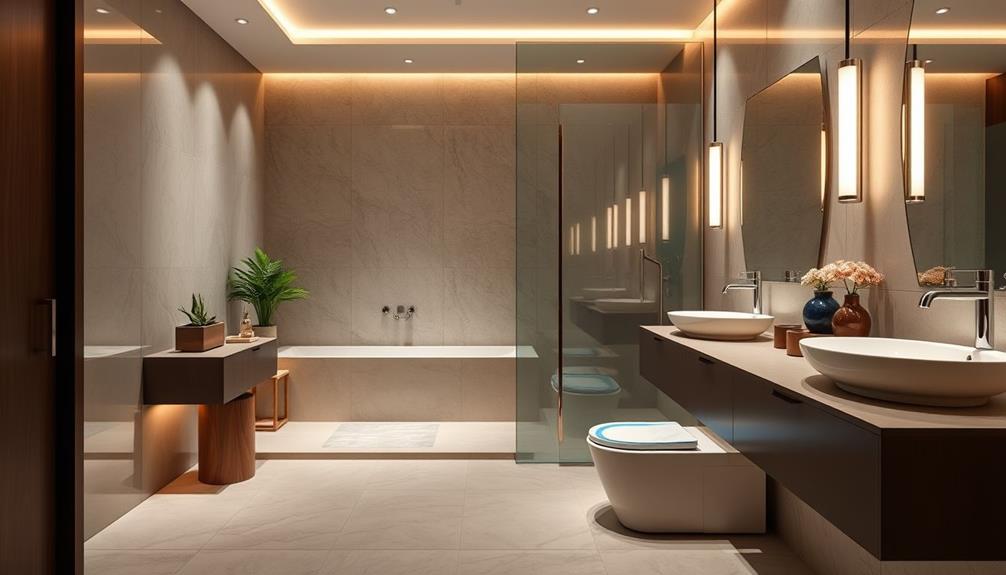
Homeowners looking to boost their property value should consider the advantages of smart toilets. In today's real estate market, these modern amenities are gaining traction and can greatly enhance your home value.
Buyers increasingly seek luxurious features in bathrooms, and smart toilets stand out as a desirable option. They not only offer convenience but also appeal to tech-savvy individuals who appreciate innovative designs. Furthermore, smart toilets often integrate with other home comfort solutions, making them a part of a cohesive, modern bathroom experience enhance home security.
Integrating smart toilets into your bathroom renovations can lead to higher appraised values, with returns on investment typically ranging from 60-70%. Buyers are willing to pay a premium for properties showcasing advanced bathroom technologies, as these features are often linked to improved hygiene and energy efficiency.
In addition, the environmental benefits of smart toilets can't be overlooked; their water-saving capabilities can attract environmentally conscious buyers, further increasing your property's marketability.
Impact on Home Sales

When you're selling your home, smart toilets can greatly boost its appeal to potential buyers.
Many buyers today prioritize modern amenities, making your property stand out in a competitive market. Incorporating such advanced fixtures, along with stylish window treatments, can enhance the overall aesthetic and functionality of your home.
Enhanced Buyer Appeal
Smart toilets can greatly boost a property's appeal to potential buyers, thanks to their innovative features like bidet functions and heated seats.
These modern conveniences not only elevate the bathroom's aesthetic but also provide enhanced comfort that many buyers are seeking today. In addition, integrating smart home technology aligns with the current trend of buyers looking for diversification of retirement portfolio through advanced home features.
This growing desire for modern amenities can markedly influence purchasing decisions.
Here are three reasons why smart toilets increase buyer appeal:
- Luxury Experience: Homes with smart toilets are perceived as more luxurious, setting your property apart in a competitive market. Features like heated seats and self-cleaning capabilities create a spa-like atmosphere.
- Energy Efficiency: Many smart toilets are energy-efficient, which aligns with buyers' growing preference for sustainable home upgrades. This makes your listing more attractive to environmentally conscious buyers.
- Improved Resale Values: Incorporating advanced bathroom fixtures like smart toilets can lead to higher resale values. Listings featuring these amenities often command better asking prices and receive more inquiries.
Modern Amenities Preference
In today's real estate market, buyers are increasingly drawn to properties that feature modern amenities. Smart toilets are among the innovative high-tech features that enhance a home's appeal. With their advanced functionalities like bidet features and automatic flushing, these toilets reflect a growing trend that captures buyer interest.
Investment in modern amenities is becoming essential for sellers aiming to maximize their property's value. In fact, 63% of realtors find energy efficiency and high-tech features valuable in property listings, making homes with smart toilets more competitive.
When you showcase luxury amenities, including smart bathrooms, you're likely to command higher sale prices. Contemporary buyers prioritize upgrades in bathroom technology, aligning with their preference for move-in-ready homes.
Properties equipped with modern amenities like smart toilets can greatly influence buyer decision-making, often swaying them toward a purchase.
As you consider selling your home, remember that integrating smart toilets can elevate its real estate value. Emphasizing these modern amenities in your property listings will attract more potential buyers, enhancing the overall home sales process.
Ultimately, investing in high-tech features not only meets the current market demand but also positions your property for success in a competitive landscape.
Increased Property Value
Modern amenities not only attract buyers but also considerably boost property value. When you incorporate smart toilets into your home, you're not just enhancing comfort; you're making a savvy investment.
Additionally, features that promote energy efficiency and sustainability, such as smart toilets, can elevate your home's appeal to environmentally-conscious buyers. Investing in modern upgrades can also provide a hedge against economic fluctuations, similar to the stability offered by gold IRAs in volatile markets.
Here's how smart toilets can elevate your property's appeal:
- Higher Sale Prices: Homes equipped with smart toilets often command higher sale prices, as buyers increasingly crave modern features that improve hygiene and convenience.
- Returns on Investment: A well-designed bathroom with smart toilet technology can yield impressive returns on investment—around 60-70%—making it an attractive option for sellers.
- Appeal to Potential Buyers: Properties showcasing luxury bathrooms equipped with smart toilets attract affluent buyers, enhancing desirability and leading to quicker sales.
The integration of smart toilets reflects contemporary trends in home design, aligning with buyers' preferences for energy efficiency and sustainability.
By investing in these modern amenities, you're likely to stand out in listings, drawing in more potential buyers and facilitating faster transactions.
Ultimately, adding smart toilets can considerably increase your property value, making it a smart choice for anyone looking to enhance their home.
User Experiences With Smart Toilets

When you try a smart toilet, you'll likely notice a big boost in hygiene and comfort, thanks to features like automatic flushing and heated seats.
Many users appreciate how these toilets can also save water and reduce maintenance needs, making them a smart investment.
Additionally, the ease of cleaning associated with smart toilets can lead to a more pleasant bathroom environment, similar to the benefits of using well-draining soil for plants that thrive in a suitable environment.
Hygiene and Comfort Benefits
With the rise of smart toilets, many users are discovering a new level of hygiene and comfort that traditional toilets simply can't match.
These innovative features not only enhance cleanliness but also transform the overall bathroom experience. Cats, like humans, can also benefit from environments that prioritize health and hygiene, reflecting the importance of maintaining a clean space for our pets cat health and nutrition.
Here are three key benefits you'll likely enjoy with smart toilets:
- Enhanced Hygiene: The bidet functions considerably reduce the risk of urinary tract infections (UTIs) compared to using toilet paper, ensuring a cleaner and healthier experience.
- Exceptional Comfort: Heated seats provide warmth and comfort, especially beneficial for elderly individuals or those with mobility issues, making the bathroom more accessible and inviting.
- Self-Cleaning Technologies: Many models come equipped with self-cleaning features that minimize bacterial growth and the need for frequent manual cleaning, contributing to a more sanitary environment.
Additionally, adjustable water pressure and temperature settings allow you to customize your washing experience.
The integration of smart controls, such as smartphone apps, enhances user experience by providing personalized settings for every household member.
At its core, smart toilets offer not just luxury but also a considerable upgrade in hygiene and comfort, setting a new standard for modern bathrooms.
Cost and Maintenance Considerations
Investing in a smart toilet can feel like a leap, especially considering the price tag that ranges from $300 to $5,000. If you're eyeing mid-range models, expect to spend between $1,000 and $2,000, not including installation costs that can add another $150 to $500.
While the initial investment is significant, the long-term savings can be quite appealing. Smart toilets are designed to reduce water consumption, potentially cutting your water usage by up to 50%. This means lower utility bills, which can offset some of those upfront costs over time.
Plus, many smart models come equipped with self-cleaning features that can lessen maintenance efforts and expenses compared to traditional toilets. User experiences also reveal that these advanced toilets often notify you of maintenance needs, helping you prevent costly repairs and ensuring longevity.
While you may face higher maintenance costs initially, the durable construction and bidet functions can lead to savings on toilet paper and fewer replacements. Ultimately, these factors can enhance your home value, making a smart toilet a worthwhile addition to your bathroom.
Cost-Benefit Analysis

Smart toilets represent a significant investment, typically ranging from $300 to $5,000, with mid-range models averaging between $1,000 and $2,000.
While the initial costs might seem overwhelming, evaluating the long-term benefits can provide clarity on the value of this modern amenity. Consider these factors:
- Installation Costs: Adding $150 to $500 for installation, and possibly $500 to $1,000 for electrical upgrades, can increase your upfront investment.
- Water Savings: Smart toilets utilize bidet functions and water-saving technologies, reducing water usage by up to 50%. This can lead to substantial savings on utility bills, appealing to eco-conscious buyers.
- Return on Investment: Homes featuring smart toilets often see heightened desirability and can sell for a premium, making it a wise investment for property value enhancement.
Ultimately, by upgrading to smart toilets, you're not just investing in modern amenities; you're also increasing your home's appeal in a competitive market.
A positive return on investment is likely, as buyers are increasingly drawn to features that align with their eco-friendly lifestyles and contemporary preferences.
Future Trends in Smart Toilets

As technology continues to evolve, the future of toilets is becoming increasingly sophisticated, transforming them into essential components of modern homes. Smart toilets are projected to become mainstream by 2024, reflecting a shift towards integrating advanced technology in everyday fixtures.
You'll find features like bidets, automatic flushing, and heated seats gaining popularity among homebuyers seeking luxury and convenience.
With a growing emphasis on environmental conservation, smart toilets can notably reduce water consumption—by up to 50%. This not only appeals to eco-conscious buyers but also enhances your property's value. The market is expanding, driven by consumer demand for innovative bathroom amenities.
Future trends show a rise in the integration of smart home systems with smart toilets, offering customizable settings and remote control functionalities.
These advancements make your home more appealing to potential buyers, positioning it as a modern sanctuary that prioritizes comfort and sustainability. As these technologies continue to develop, investing in smart toilets could be a smart move that elevates your lifestyle while boosting the overall attractiveness of your home in the real estate market.
Frequently Asked Questions
Are Smart Toilets a Good Investment?
Smart toilets can be a great investment for you. They offer modern convenience and enhanced hygiene, while potentially lowering water bills. Plus, their appeal could attract more buyers if you decide to sell your home.
Does a Separate Toilet Add Value?
Picture a bustling family home—adding a separate toilet definitely boosts your space's appeal. It enhances convenience, attracts enthusiastic buyers, and can increase your property's market value, making it a smart move for any homeowner.
How Important Is the Master Bathroom When Selling a House?
When selling a house, the master bathroom's essential. It greatly influences buyers' decisions, and a well-designed space can lead to faster sales and higher offers, making it a key investment for your home's value.
Conclusion
To sum up, smart toilets aren't just a trendy addition; they're a game changer for real estate. Imagine stepping into a home where comfort meets innovation, all while boosting property value. As more buyers seek out these high-tech amenities, investing in smart toilets could mean the difference between a quick sale and lingering listings. So, why not embrace the future now? After all, in the world of real estate, the throne you sit on could elevate your entire kingdom.
With an impeccable eye for detail and a passion for bathroom-related, Ava leads our editorial team gracefully and precisely.
Under her guidance, Best Modern Toilet has flourished as the go-to resource for modern bathroom enthusiasts. In her free time, you might find Ava exploring antique shops and looking for vintage bathroom fixtures to add to her collection.
Guides
How Smart Toilets Can Help Detect Early Signs of Health Issues
How can smart toilets revolutionize health monitoring? Discover the surprising ways they detect early signs of health issues and empower your wellness journey.
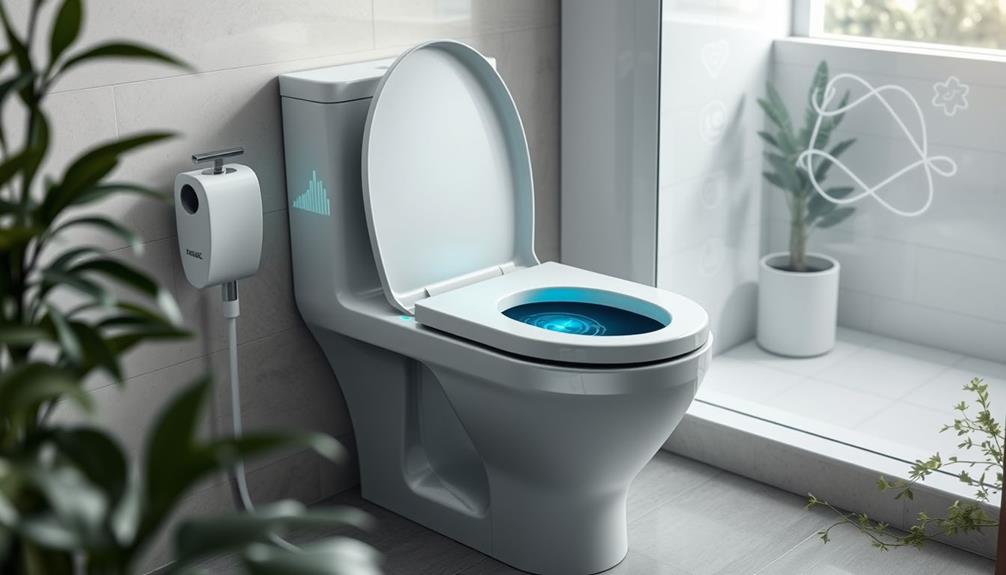
Smart toilets can alert you to early signs of health issues by analyzing your waste for key biomarkers and crucial indicators. They monitor urine color, flow rate, and stool consistency, providing real-time insights into your health. With advanced sensors, these toilets can identify potential problems like diabetes or kidney issues before they escalate. The non-invasive nature of this technology allows for continuous health monitoring, making it easy to track changes over time. By understanding your health trends, you'll be empowered to take proactive steps. Curious about how these innovations work? There's much more to explore!
Key Takeaways
- Smart toilets analyze urine and stool, identifying biomarkers that signal early signs of diseases like diabetes and kidney issues.
- Continuous monitoring of urine color, flow rate, and fecal consistency enables timely detection of health changes.
- Non-invasive assessments through smart toilets eliminate the need for invasive testing, making health monitoring more accessible.
- Real-time insights prompt users to seek medical consultations sooner, enhancing the likelihood of early disease intervention.
- Data trends collected over time facilitate proactive healthcare measures, improving overall health outcomes in communities.
Smart Toilet Technology Overview
Smart toilet technology is revolutionizing how we monitor our health in everyday life. These innovative devices use advanced sensors to analyze your urine and stool, providing real-time insights into your health. By detecting various health indicators and biomarkers during routine use, smart toilets enable you to stay informed about your well-being effortlessly.
Additionally, toilet maintenance practices can enhance the longevity and performance of these smart devices, ensuring they function effectively.
Equipped with artificial intelligence algorithms, smart toilets interpret your biological data and offer personalized insights through connected mobile apps. They monitor essential health metrics like urine color, flow rate, and fecal consistency, helping identify early signs of conditions such as diabetes, kidney disease, and certain cancers. This capability allows for timely disease detection, giving you a proactive approach to health management.
Smart toilets securely transmit the collected biological data to the cloud, facilitating continuous monitoring without requiring any additional effort from you. Their seamless integration into existing toilet fixtures makes health monitoring accessible and non-invasive for everyone in your household.
With this technology, you can take charge of your health like never before, ensuring that you're aware of potential issues before they escalate. Embrace the future of health monitoring with smart toilets, and stay ahead of your health journey.
Health Monitoring Capabilities
With smart toilets, you can easily monitor your health from the comfort of your home, detecting potential diseases like diabetes or kidney issues early on.
These devices provide continuous health insights, allowing you to track changes over time. Incorporating regular physical activity can further enhance these health monitoring capabilities, as it plays an essential role in overall well-being and menopause management.
However, it's important to reflect on how your health data is protected as you embrace this technology.
Disease Detection Capabilities
The emergence of innovative toilet technology brings a new dimension to health monitoring, allowing early disease detection right from your bathroom. Smart toilets utilize advanced sensors to analyze urine and stool samples, identifying potential health issues such as diabetes, kidney disease, and various cancers through specific biomarkers found in waste. This real-time data can alert you to abnormal health trends that might otherwise go unnoticed.
Additionally, mental health support is essential for cognitive health maintenance, as physical health can impact emotional well-being.
By monitoring important indicators like urine color, fecal morphology, flow rate, and volume, smart toilets provide insights into your health that facilitate chronic disease management. If any concerning results arise, these systems can send alerts to your healthcare providers, ensuring timely interventions when necessary.
Research indicates that consistent monitoring can help detect signs of illness over time, enabling early intervention and potentially reducing healthcare costs through preventive care strategies.
Additionally, the integration of optical scanning technology enhances the precision of waste analysis, allowing for detailed assessments of metabolic changes and hydration levels. With smart toilets, you can take charge of your health in a way that's both convenient and informative.
Continuous Health Monitoring
As you go about your daily routine, continuous health monitoring through advanced toilet technology offers a seamless way to stay informed about your well-being.
Smart toilets equipped with cutting-edge sensors provide real-time monitoring by analyzing your urine and feces. This enables them to detect vital health indicators such as hydration levels and the presence of disease biomarkers.
Hydration is vital for overall health, and these smart toilets can help guarantee you maintain adequate fluid intake.
With the ability to measure multiple biomarkers simultaneously, these toilets allow for thorough health assessments during your normal toileting habits, eliminating the need for invasive testing.
This continuous health monitoring can identify early signs of serious conditions like cancers, diabetes, and kidney issues, enabling timely alerts for any abnormal health conditions.
Data Privacy Considerations
Data privacy is an essential factor when it comes to smart toilets and their health monitoring capabilities. As these devices gather health data through advanced sensors, guaranteeing privacy is critical. Smart toilets can detect early signs of health issues like diabetes or kidney disease, but this data must be securely handled to maintain your trust.
The increasing focus on cybersecurity and system vulnerabilities emphasizes the need for robust security measures in health monitoring technologies.
To protect your information, smart toilets employ user identification features, such as fingerprint scanning and facial recognition. This guarantees that your health data is personalized and securely stored. Compliance with privacy regulations, like HIPAA, is fundamental to safeguard against unauthorized access and misuse of sensitive information.
Moreover, the integration of consent frameworks is necessary. You should be fully informed about how your data will be used, stored, and shared, which fosters trust and encourages participation in health monitoring initiatives.
Real-time monitoring provides individualized health insights, but it's crucial that you feel confident in the data security measures in place. By prioritizing these considerations, smart toilets can offer valuable health insights while protecting your privacy.
Early Detection of Diseases
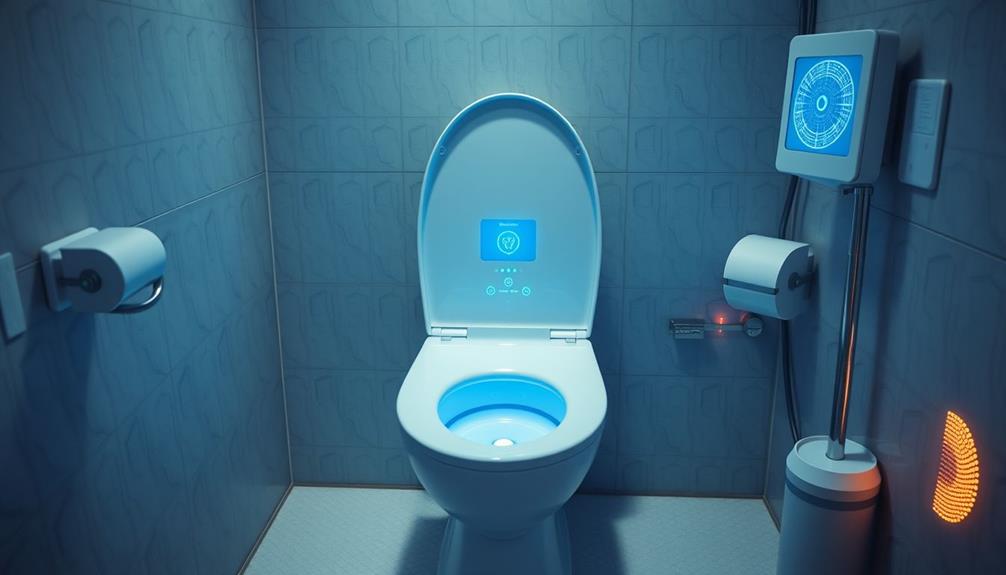
Smart toilets offer a groundbreaking way to analyze biomarkers in your urine and stool, helping catch early signs of diseases like diabetes and cancer.
These innovations can complement traditional screening methods, like mammography guidelines, by providing continuous health monitoring.
By continuously monitoring your health, these advanced systems provide personalized insights that can lead to timely medical interventions.
With this non-invasive technology, staying on top of your health has never been easier.
Biomarker Analysis Capabilities
The rise of innovative health technologies has transformed how we monitor our well-being, with smart toilets leading the charge in biomarker analysis. These advanced devices utilize sensors to conduct urine analysis, examining biomarkers that can reveal early signs of diseases like diabetes, kidney failure, and various cancers.
Notably, much like how cats exhibit signs of attachment to their owners, smart toilets can form a connection with users by continuously tracking their health data. By monitoring health indicators such as hydration levels and metabolic changes, smart toilets offer a thorough approach to health monitoring.
Through real-time analysis of waste samples, these toilets can identify essential health issues, facilitating timely disease detection. For example, they can screen for urological and colorectal cancers by detecting specific biomarkers that indicate illness. This capability is vital because catching diseases early can greatly improve treatment outcomes.
The integration of optical scanning technology further enhances the smart toilet's ability to perform continuous monitoring, alerting you to any abnormal health conditions. By providing insights into your body's health through minute changes in urine and stool, smart toilets empower you to stay proactive about your health.
With this level of monitoring, you can take charge of your well-being and seek medical consultations when necessary, ensuring that you stay ahead of potential health issues.
Continuous Health Monitoring
With the ability to analyze biomarkers in waste, smart toilets take health monitoring a step further by providing continuous surveillance of your well-being. These innovative devices utilize advanced sensors for urine analysis and stool analysis, enabling real-time disease detection. They can identify early signs of health issues, including diabetes, infections, and various cancers, by closely monitoring changes in urine color, consistency, and flow rate.
Additionally, understanding the importance of maintaining a healthy weight, similar to how dog owners must monitor their pets' diets, can play a vital role in overall health management dog nutrition insights.
By integrating continuous health monitoring into your daily routine, smart toilets offer a non-invasive approach to tracking important health metrics. This passive monitoring requires no effort on your part, allowing you to stay informed about hydration levels and gastrointestinal health without disrupting your life.
Research shows that smart toilets can analyze up to ten different biomarkers, making them a powerful tool for early disease detection and chronic disease management.
The potential of smart toilets to revolutionize personal health management lies in their ability to provide longitudinal health insights. With continuous data collection, they facilitate proactive interventions, helping you address potential health issues before they become severe.
Embracing this technology means taking a significant step toward better health awareness and management.
Personalized Health Insights
Imagine having a personal health assistant that discreetly monitors your well-being every time you use the bathroom. Smart toilets offer just that, utilizing advanced sensors for health monitoring through urine analysis. They provide personalized health insights by detecting specific biomarkers in your waste, revealing early signs of disease, including cancers like colorectal and urological cancer.
Additionally, just as Gold IRAs provide a hedge against inflation and economic uncertainty, smart toilets can serve as a proactive measure for your health, allowing you to stay ahead of potential issues.
With continuous monitoring, these toilets analyze changes in urine color, consistency, and volume, alerting you to potential health issues. This real-time insight can encourage timely medical consultations, making a significant difference in your health outcomes.
Plus, the integration of cloud-based technology guarantees your data is stored securely and analyzed effectively, all while respecting your privacy.
The non-invasive nature of smart toilets allows for effortless health tracking, enabling you to understand your health trends over time. With this information, you can take proactive steps toward personalized health management, addressing any abnormalities before they escalate.
Data Privacy and Security

Steering through the world of smart toilets means being mindful of data privacy and security. These innovative devices collect sensitive health information, making it essential to understand how your data is protected, especially in a landscape where credit card debt in the U.S. continues to rise and data breaches are prevalent.
Here are four key aspects to take into account:
- Encryption: Smart toilets use advanced encryption methods to securely upload your health data to cloud servers, preventing unauthorized access.
- Anonymized Data: Before transmission, your data is anonymized and deidentified, ensuring compliance with standards like HIPAA and the EU's General Data Privacy Rule.
- Informed Consent: Clear communication about data storage practices and potential sharing is vital. You should always be aware of how your data is handled.
- Biometric Identifiers: Features like fingerprint and anal print recognition enhance user identification while implementing strict privacy measures to safeguard your health data.
As technology advances, staying informed about data privacy frameworks becomes even more important. The risk of reidentification of anonymized data could impact your privacy.
User Identification Features
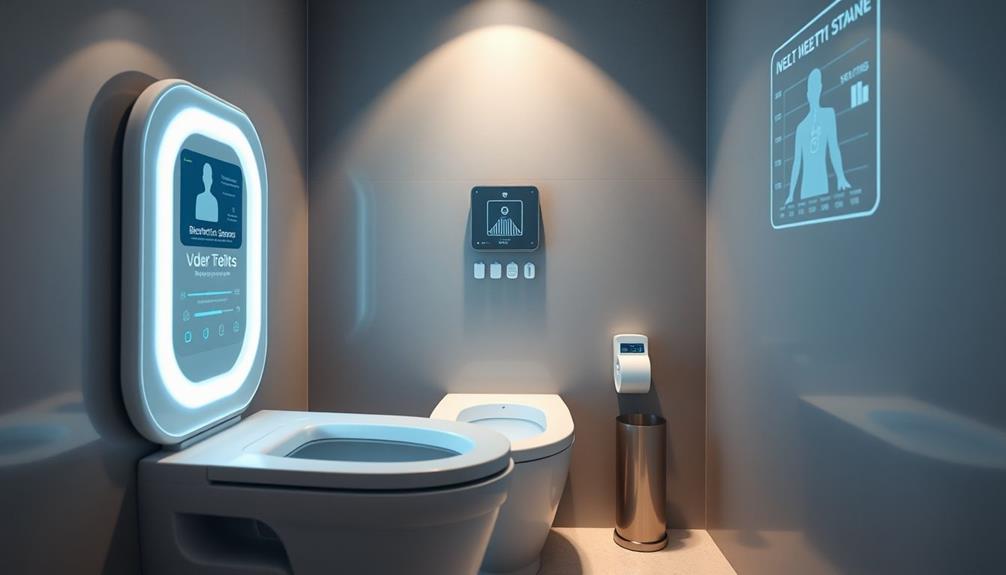
User identification features in smart toilets play an essential role in delivering personalized health insights. By employing advanced user identification methods like fingerprint recognition on the flush lever and an innovative anal print scanner, smart toilets guarantee that health monitoring is tailored to you. These unique identifiers enhance security and provide accurate feedback based on your individual data.
Smart toilets can also utilize facial recognition or user profiles, allowing them to adjust health insights according to your health history. This means that the data collected is more relevant and beneficial for your specific needs. Your health information is securely encrypted and uploaded to cloud servers, assuring that your personalized health information remains private and accessible only to you and authorized healthcare providers.
To further protect your sensitive data, smart toilets comply with HIPAA regulations, which safeguard your health information. Additionally, efforts to anonymize health data before transmission reinforce data privacy, giving you peace of mind.
With these sophisticated user identification features, smart toilets not only enhance convenience but also revolutionize the way you monitor your health, making it more personalized and secure.
Ethical Considerations
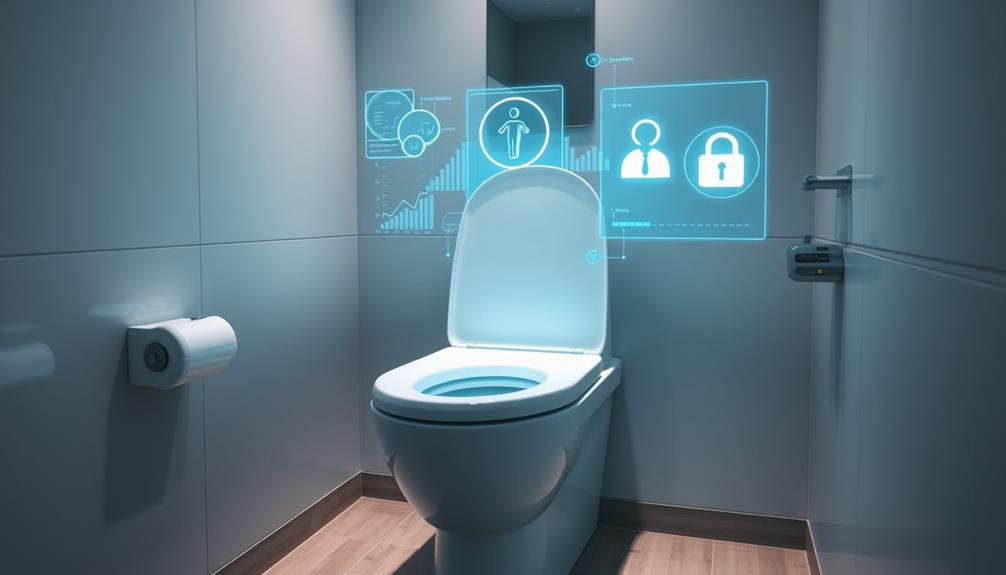
As smart toilets become more integrated into daily life, ethical concerns surrounding user privacy and data handling are increasingly in focus. You need to reflect on several key ethical challenges in collecting and managing sensitive health data:
- User Privacy: Safeguarding your information is paramount, especially when dealing with personal waste data.
- Informed Consent: It's vital that you're adequately informed about how your data will be stored, shared, and utilized, particularly for incidental findings.
- Cultural Taboos: Discussions about toileting habits can be sensitive, which may hinder acceptance. Effective communication strategies are essential to address these issues.
- Health Inequities: Access to technology must be equitable, ensuring smart toilets benefit a diverse population without worsening existing disparities.
The regulatory framework around smart toilets also affects data protection. Whether they're classified as consumer electronics or medical devices influences the security measures in place.
You should be aware of these dynamics, as they can impact not just your personal data security but also broader societal implications in health and wellness.
Balancing innovation with ethical considerations is essential as we move forward with this technology.
Public Health Implications
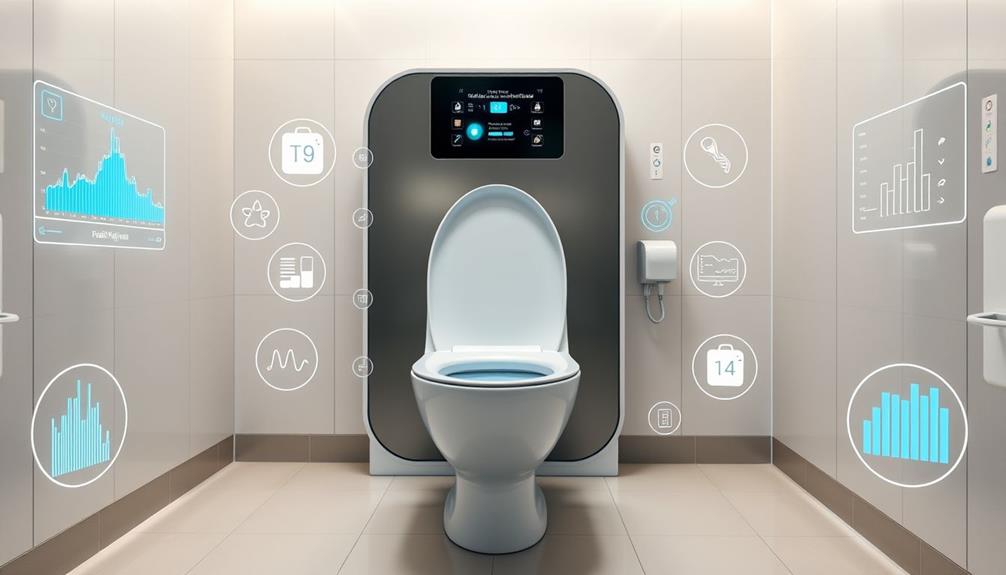
How can smart toilets revolutionize public health? These innovative devices can facilitate early disease detection by analyzing wastewater for health markers. Imagine a network of smart toilets shifting the focus from collective data to personalized health monitoring within communities. This change could enable real-time health monitoring and alert you to any emerging health issues.
| Benefits | Implications |
|---|---|
| Early Disease Detection | Reduces healthcare costs |
| Personalized Health Monitoring | Enhances community health |
| Chronic Disease Management | Supports proactive health measures |
The continuous data collection from smart toilets provides valuable insights into population health trends. This information can aid in identifying emerging health issues and improve chronic disease management on a larger scale. By integrating smart toilets into public health systems, we can greatly enhance our ability to respond to health crises. You'll find that this technology not only benefits individual health but also fosters a healthier community overall. As smart toilets become more widespread, they can play an essential role in shaping public health strategies and improving overall well-being.
Future Directions in Smart Toilets

With advancements on the horizon, smart toilets are poised to transform personal health monitoring in ways we haven't yet imagined. These innovations could redefine how you approach your health and wellness, offering real-time insights that enhance your daily life.
Here are some future directions for smart toilets:
- Advanced Molecular Analysis: Expect smart toilets to conduct thorough stool tests, detecting a broader spectrum of health issues, including gastrointestinal disorders.
- Integrated Digital Health: By connecting with digital health platforms, smart toilets can provide personalized health recommendations based on your unique data trends.
- User Differentiation Technology: Smart toilets may soon incorporate features that distinguish between multiple users, offering tailored insights for each family member.
- Public Health Surveillance: These toilets could play a significant role in monitoring health trends and outbreaks through individual waste analysis, providing essential data that surpasses traditional methods.
As sensor accuracy and data interpretation improve, smart toilets will shift towards preventive health care, allowing for early detection of potential health issues.
The future of health monitoring lies in these innovative devices, making personal and public health insights more accessible than ever.
Frequently Asked Questions
How Smart Toilets Can Monitor Health?
Smart toilets monitor your health by analyzing your urine and stool with advanced sensors. They track essential metrics, like hydration and gastrointestinal health, sending alerts when abnormal results are detected for timely medical attention.
Why Are Smart Toilets Important?
Smart toilets are essential because they provide you with real-time health insights effortlessly. By monitoring crucial metrics, you can proactively manage your well-being, detect potential issues early, and ultimately improve your overall health and quality of life.
What Is a Smart Toilet With Urine Analysis?
A smart toilet with urine analysis uses advanced sensors to monitor various health indicators. It analyzes your urine for biomarkers, offering insights into your health, like detecting infections or metabolic changes without any invasive procedures.
Is There a Smart Toilet That Identifies Analprints?
Yes, there are smart toilets that identify anal prints. This technology uses unique patterns for user identification, enhancing privacy and ensuring personalized health monitoring without exposing sensitive information to others. You'll enjoy tailored insights.
Conclusion
In a world where every flush could be a lifeline, smart toilets are stepping up as silent guardians of your health. They transform an ordinary bathroom into a personal health hub, catching subtle signs of trouble before they snowball. As technology swirls around us, embracing these innovations can empower you to take charge of your well-being. So, next time you sit down, remember: you might just be sitting on the future of health monitoring!
With an impeccable eye for detail and a passion for bathroom-related, Ava leads our editorial team gracefully and precisely.
Under her guidance, Best Modern Toilet has flourished as the go-to resource for modern bathroom enthusiasts. In her free time, you might find Ava exploring antique shops and looking for vintage bathroom fixtures to add to her collection.
-

 Bathtub2 months ago
Bathtub2 months agoAre Clorox Toilet Wand Refills Septic Safe
-

 Reviews2 months ago
Reviews2 months agoLoupusuo Luxury Smart Toilet Review [2024]
-

 Reviews2 months ago
Reviews2 months agoSimple Project Modern Smart Toilet Review [2024]
-

 FAQ - Advanced Bathroom Queries2 months ago
FAQ - Advanced Bathroom Queries2 months agoWhat to Do if You Accidentally Flush a Paper Towel
-

 Toilet Brands2 months ago
Toilet Brands2 months agoCan You Put Toilet Paper Down the Toilet in Cyprus
-

 Reviews2 months ago
Reviews2 months agoLDian Smart Toilet Review: Luxury and Hygiene Combined [2024]
-

 FAQ - Advanced Bathroom Queries2 months ago
FAQ - Advanced Bathroom Queries2 months agoWhat to Do if a Toilet Paper Roll Gets Flushed Down the Toilet
-

 Reviews2 months ago
Reviews2 months agoWhich Is Better Flush Valve or Flush Tank






















